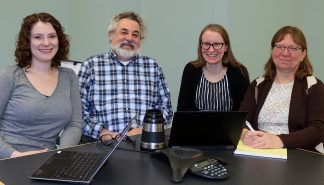By Jon Jeffryes
What impact does the research conducted at the University of Minnesota have on the wider world?
Guess what? Much of it can be measured — and the University Libraries has been assisting researchers navigate impact metrics for years. These metrics aim to quantify the influence of a researcher or research article. But as the metrics have been largely focused on citation counts in academic research papers, they don’t clearly show the ways that university research impacts the world beyond the academic realm.
A new service at Libraries, however, is widening the scope of impact metrics available to researchers and helps them see a more complete view of the impact of their work.
Introducing the Policy and News Media Impact Service
“If practitioners are trying to change health behaviors and if other practitioners are reading their work and applying it; they might not necessarily turn around and publish an article on it,” says Caitlin Bakker, a Research Services Liaison at the Bio-Medical Library. “But health is changing as a result of that activity, so how can we represent that?”
Welcome to the Policy and News Media Impact Service, which was recently launched by the Libraries’ Bakker, Katherine Chew, Jenny McBurney, and Del Reed.
Using the service is simple. Researchers fill out a short online form that gives Bakker and her team information on which research projects they are hoping to track. That information might include citations of papers they have published or grants that they have been awarded. Researchers can also designate whether they are interested in only the impact their work has had in shaping public policy (found by reviewing references and mentions in policy documents), only the impact their work has seen from coverage in the media, or a combination of both.
The librarians take that information and consult a list of up to 18 different resources that focus on public policy and news media, seeking to fill in the gaps that traditional metrics leave in their measurements.
The work utilizes librarians’ expertise around matching information needs with relevant information resources. Bakker also describes using creativity and persistence in mining the information from challenging media references to determine impact. News stories do not always list full citations for the studies they’re reporting on. Instead, they will often refer generally to “a study from the U of M” or use other vague language.
“There’s an element of detective work to it,” Bakker says. “It feels like you’re uncovering something.”
After their thorough review, the team brings the findings from the various resources into a single report that they present to the researcher.
Pilot demonstrates early success
The information provided in the reports has a variety of applications.
“We have had folks who used this information in grant applications for NIH to show that their previously funded research had public health value,” says Bakker. “A couple of faculty are using it for their promotion and tenure dossiers.”
The service is still in a pilot phase and is currently only open to researchers in Family Medicine & Community Health, Pediatrics, Epidemiology & Community Health, Center for Bioethics, and Pharmaceutical Care & Health Systems.
Bakker and her colleagues plan to evaluate the pilot and determine the next steps needed to expand the service over the next few months.
‘A great feedback loop’ for researchers
Lisa Harnack, an epidemiology professor in the School of Public Health, was an early user — and proponent — of the service. She conducts research with the goal of informing public policy. This service helped her get a clearer picture about the effect of her work.
“It’s a great feedback loop to know whether your research is reaching its intended audience,” Harnack says. “Right after I got my report back from Caitlin, I emailed a number of my colleagues who do policy-related research and I suggested that they request reports for their research.”
Along with demonstrating the successful impact of research projects, the service can also show which publication avenues aren’t connecting with policy makers or news media. This information allows researchers to make more fully informed decisions in their publication strategies.
- Learn more about the Policy and News Media Impact Service





